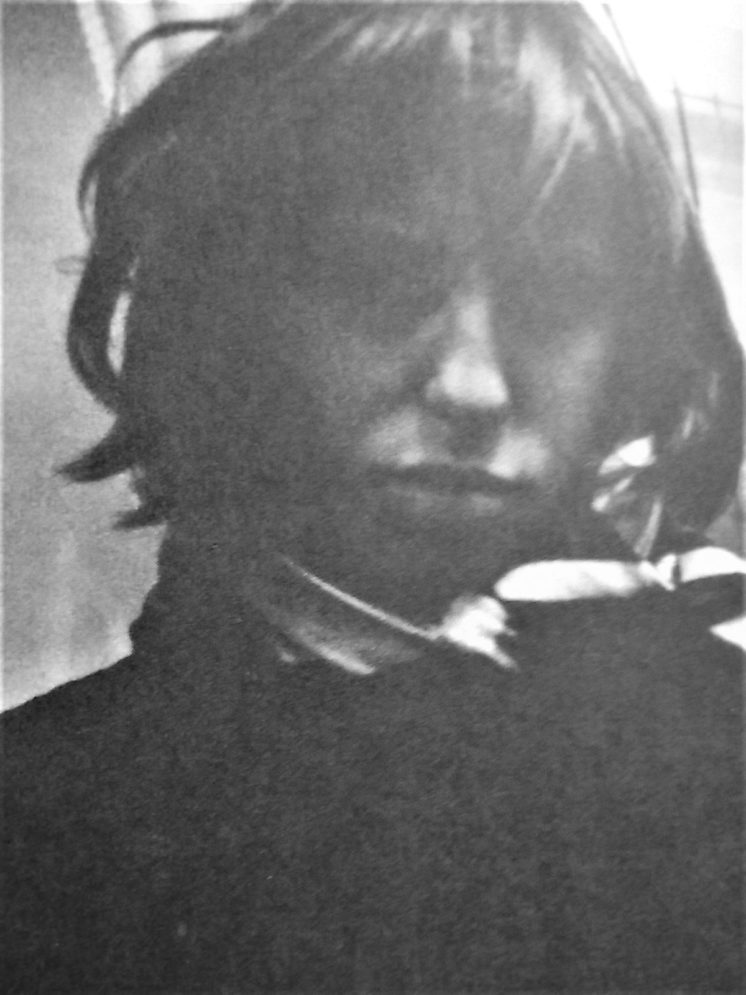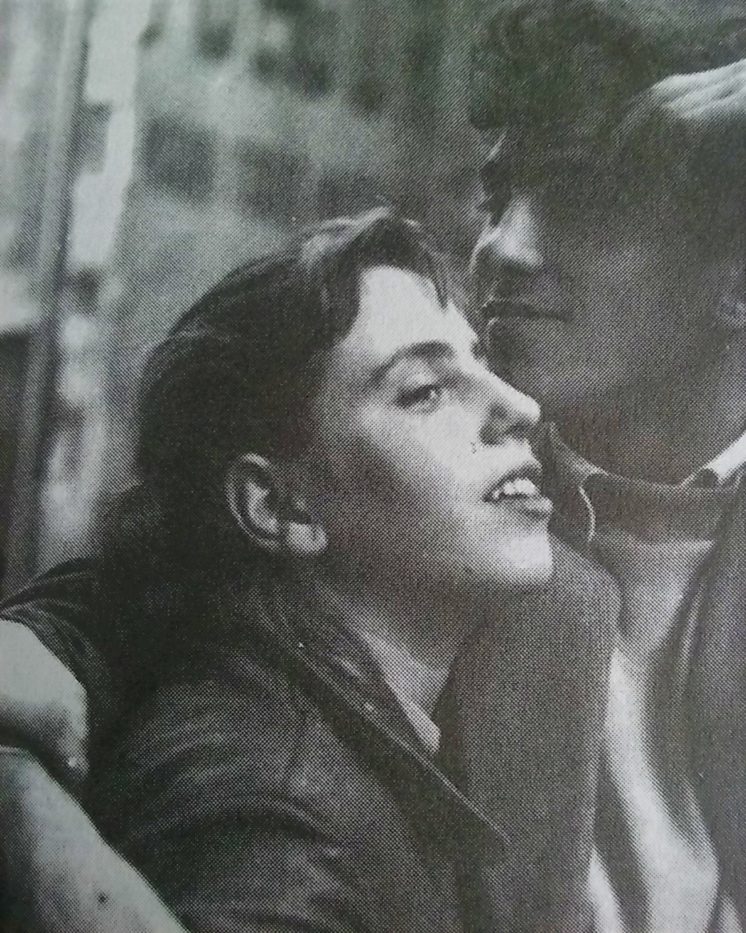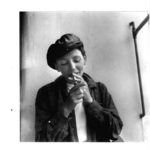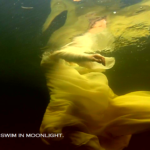Avant-Garde Women: Eliane Brau, the Invisible Icon
Born Eliane Papai around 1935 in Spain, Eliane married her way into a couple other last names; she is mostly referred to as Eliane Brau, using the last name of her second husband. I think of her simply as Eliane, in deference to her singularity. Below I argue that her role in the “Letterist” movement of early 1950s Paris has been diminished; conversely, the achievements of the Letterist men have been overblown. It has been too easy to write her off as a passive “muse” for these men who indeed loved her fiercely. She deserves parity. Sadly, unlike her lovers, there is a distinct lack of information about her on the internet. I cannot even determine if she is still alive. Eliane is an invisible icon.

Eliane. Bad copy of a great photo by Ed van der Elsken/The Netherlands Photo Archives. As published in The Tribe by Jean-Michel Mension. I believe it is this photo Mension praises below as showing “all the hate in the world, all the fear in the world, all the violence, all the refusal…”
Letterism
(More commonly spelled “Lettrist” in America, I have opted for the preferred European spelling “Letterist.”) Eliane was an early member of the Letterist International, a group of young, radical, artist-philosophers trying to re-imagine war-shattered Europe. They were active between 1952-1954. For the most part, when Eliane’s name crops up at all, it is as a signatory to a manifesto or two, a mere footnote to Letterist history – itself very obscure.
The Letterists may be considered one of the stepping stones in a lineage of avant-garde, “anti-art” art movements: Dadaism circa 1915 begat Surrealism in the 1920s, which tipped into Letterism in the early 1950s, which begat Situationism, which begat the May 1968 uprising in France. That is a rough but essentially correct chronology of these related movements. (A definitive history may be found in Lipstick Traces: A Secret History of the Twentieth Century by Greil Marcus.)
Each movement wanted a decisive break from the previous one; it is only in retrospect, with the benefit of art history, that their similarities allow them to be mentioned in the same breath without fisticuffs. Letterist Jean-Michel Mension goes into this in some detail in The Tribe (Mension interviewed by Gerard Berreby and Francesco Milo) where he says things like, “We were duty-bound to denounce the Surrealists” (p. 118).
European politics in the early 1950s were messy and dangerous. Anarchism and communism seemed like valid options among the left, even as various factions of each “in some University departments… were literally at daggers drawn” (The Tribe, p. 123). Meanwhile Paris was being reconstructed and this led to lively critiques of architecture and urbanism, and with it, a larger critique of art as consumerist. The Letterists formed amidst this ferment and eventually evolved into the Situationists, who continued the Letterist critiques of everything while denouncing Letterism for lack of political purity.
History remembers Guy Debord as the prime mover of the Letterist-Situationist axis. It was Debord who (like Andre Breton of the Surrealists, and like the Stalinists) enforced party lines with exclusions. One could be kicked out of the Letterists for selling one’s art – because that made you part of the system. The ideal of Letterism (and subsequently Situationism) was to live life as art, without money and without working. Panhandling, theft, or sleeping with someone with a job were the only cool ways to get money. And they needed money for constantly drinking in bars and cafes, which was their primary activity. But having a job simply wasn’t done.
On the run from the Juvenile Squad, Eliane signed the Letterist manifesto in 1953 along with three other women and seven men. Among that number was Eliane’s ex-boyfriend (Debord), her husband (Mension), and her future husband (Brau). Debord would exclude all of them from the group within a year’s time.
It’s unclear to me whether or not Eliane was ever formally excluded, or if it had been merely enough to exclude her husband Mension. When asked in The Tribe if Eliane was considered a Letterist at all, Mension said, “Not so much.” In one of Debord’s letters from 1953, he mentions “Brau and his wife are traveling in Algeria”, so that tracks. What he should have said is, “Brau and my ex-girlfriend, Mension’s ex-wife, are traveling in Algeria”. Although she clearly was enough of a Letterist to sign the early manifestos, the men who really ran the group — who all loved her — denied her a substantive role in their histories.
Situationism
What did she do from 1954 on, for the rest of her life? No clue. Substantive information does not appear to exist.
Except that, in 1968, she wrote her own history of the Letterist-Situationist movements, the book Le Situationnisme ou la nouvelle international. I am not aware of an English translation and so I have not read it. I can only hope translators are feverishly working on it.
I found a translation of a brief 2016 French critique (“The history of the SI will be written later”) of her book, written apparently by a pissed-off Situationist:
One has to be a critic of the caliber of Maurice Joyeux (La Rue, No. 4, 2nd Qtr. 1969) to think, or to pretend to think, that [Eliane was] ever part of the SI. And one must, no doubt, be a student to believe that [she] might have understood the slightest thing about what we are. [….] Mrs. Eliane Brau has, in Situationism or The New International [2] (New Editions Debresse 4th Quarter, 1968), produced an incomprehensible compilation of situationist texts, where even knowledge of how to use inverted commas escapes her: her quotations begin very often, but don’t end. On the evidence of such “extracts” debased by such commentary, one is bound to wonder what could “worry the Interior Ministries of every country” (using the words of the provocative advertising for the book) about this Situationist movement.
This shrill critique is laughable. Eliane was not a part of the SI, we know that; it is hardly a source of outrage to merely point that out. But is it not relevant that she was in the precursor movement, Letterism? That she helped invent the Situationist derive? That Situationist founder Guy Debord himself loved her? Eliane occupied a unique position central to Letterism becoming Situationism. She knew all the participants personally because she herself had been a central participant, until Debord kicked her and everyone else out in one of his manias. Regarding the charge that her book contains “an incomprehensible compilation of situationist texts”: Situationist texts themselves are intentionally incomprehensible. Try reading Debord’s defining text Society of the Spectacle sometime. How does compiling incomprehensible texts make Eliane the villain? And the complaining about inverted commas and “provocative advertising” are more properly directed at the book’s editor. On the face of it, the critique has no weight.
In The Tribe, I found a couple paragraphs of Eliane’s book excerpted in translation, among them this passage:
The life of the Situationist International cannot be disentangled from Saint-Germain-des-Pres and the climate that once reigned in that neighborhood. The Letterist International had set up its headquarters at Moineau’s, a low dive in Rue du Four where the Letterists were joined by hitherto unaffiliated young revolutionaries. Drugs, alcohol, and girls (especially underage girls) were part of the folklore of the Letterist International, as revealed in certain slogans of that time which, curiously enough, reappeared on the walls of Paris in May 1968: ‘Never work!’ ‘Ether is freely available,’ or ‘Let us live!’
Eliane
Eliane was, in fact, one of those underage girls. She dated Debord (then in his early 20s) while she was under 18, and then married the 18-year-old Mension just shy of her own 18th birthday. She seems to be including herself in the class of “unaffiliated young revolutionaries” who “joined” the Letterists. But perhaps she is only noting that she became “part of the folklore” by being one of the underage girls.
But the matter of who was “officially” in the group almost has zero meaning, what with Debord’s trigger-happy exclusions of even the most established figures. What is undeniable is that Eliane played a constant role in the center of it all. She took part in many of its founding conversations and actions. The group produced manifestos which she signed. They also made some experimental films to which she gave her labor. (We know this because artist Jacques Villegle mentions in his book Urbi et orbi seeing her circa 1953 as part of a Letterist film crew who had turned a miniature Paris apartment into a film studio: “…Eliane Papai, in-betweener of the moment, at the focusing screen…”)
But let’s not kid ourselves. The Letterists were artists who produced almost no art – being fundamentally against it – and their films were purposefully unwatchable, designed sheerly to provoke. The same is true of most of their theoretical writing, and I say that as a fan — it’s unreadable (and I have a high tolerance for unreadability). Debord for instance is a well-known obscurantist, the better to frustrate critics and to claim almost any meaning from the work. One of Letterism’s noted achievements was “sound poetry” (breaking words back into letters, hence “Letterism”). But sound poetry had, in fact, been invented before even the 1916 Dadaists.
The famous “drifts” invented by the Letterists, including Eliane – which are presented to this day as revolutionary explorations of urban ambience – were in fact bar-crawls from café to café. They wanted life to be lived as art — and that life consisted almost entirely of hard, late-night drinking, animated discussions, and petty crime. Those were the standards of the Letterists’ pure artistic vision.
By those standards, Eliane was more than a muse, more than a girlfriend or a wife, and more than a spectator with a front-row seat. She was one of the Letterists’ most vital and accomplished members.
The Tribe gives the fullest accounting I have found of who Eliane was, and thank God for this book. Ex-husband Mension provides this bracing yet affectionate portrait of her; published in 1998, it was around fifty years after the fact:
Q: Eliane, who had been Debord’s girlfriend, then became your wife, then the wife of Jean-Louis Brau, played an important part through those years.
A: Eliane was a rebel…. a Hungarian-Spanish mixture, and sometimes it was explosive…. She didn’t go to her [juvenile-court-ordered job-training] classes much… instead, she would come down to the neighborhood to smoke a little hash; she loved hash, and we used to smoke a lot of it…. When she came to the neighborhood and smoked, we didn’t stay there. I often went with her under a bridge…. Soon she started drinking because everybody else drank. You couldn’t stay in that bar [Moineau’s] and not drink. At twelve-thirty or one in the morning [on our wedding night] we left Moineau’s and went over to settle some outstanding business with the owner of the Mabillon, who a few days earlier had called the cops on Eliane. The help locked the café doors, and the boss came out to palaver. Eliane insulted him. I must have done the same. At some point Eliane asked me what to do next, and I said to her very agreeably, “Kick him in the balls, for good measure” – which she proceeded to do without hesitation…. We spent our wedding night in the police station….
Q: Was Eliane merely a rebel? Wasn’t she almost wild?
A: She was wild, yes, even mean, horrible – she was a scandal. She was just fine and, I would say, magnificent…. I remember at least two [bars] where Eliane stripped her clothes off and started dancing on the table at one in the morning. The customers loved it, even though as she danced, half Spanish, half Gypsy, and half drunk, she was knocking their drinks onto the floor. They were as happy as could be. That was typical Eliane, always causing something of a scandal. Sometimes she would have a cleanliness crisis and start washing her panties out in the gutter….
Here’s a good Eliane story. Often, around two in the morning, when Moineau’s closed, we would take the same short route… to the Saint-Claude… By tradition, we would take a piss en route in a corner where everybody used to piss. One night, just to give us a bad time, the cops came down on us: wham-bang! drunk and disorderly! They knew the lot of us. Your papers, please, the whole she-bang – not excluding Eliane, who had pissed along with everyone else and who was now shouting, ‘Not on your life! I would never piss in front of guys!’ In a word, she was putting on a great show. Her cop was pretty good-humored, and he didn’t give a damn what she was on about. Then Eliane goes, ‘Look, I can prove that I didn’t piss.’ She pulls down her panties, squats, and starts pissing all over again in front of the cop. So the cop slaps her with another ticket. I reckon it must be a world record… two summonses for drunk and disorderly conduct in the space of fifteen minutes.
Q: So she had great timing and she loved to provoke.
A: Oh, yes. She was an absolute menace whenever we landed in the police station. Which was very often. There was a time when we were regularly being run down there two or three times a week. There were three police stations… We would go to one or another of them according to their rotations. There were nights when we paid visits to all three. Eliane’s great specialty was clinging to the bars of the holding cage they had at the station. At first we wouldn’t be put in cells; but confined in that tiny space, Eliane would clamp herself onto the bars, screaming… and she would go on for a very long time indeed. After a while the cops would toss us into the cells, but in the meantime, Eliane was completely insufferable. That’s what I loved about her: she was whole and entire. That’s what we all loved, in fact – Guy, Jean-Louis, and I. I think we all had the same vision of Eliane. In Debord’s Complete Cinematographic Works there is a fantastic photo of her: it shows all the hate in the world, all the fear in the world, all the violence, all the refusal… she was truly a great lady.
Compare that to the brief description of Eliane in The Consul by Ralph Rumney (Rumney interviewed by Gerard Berreby):
Q: Brau had been married to Eliane. Did you know her?
A: Yes, very well. She was vulgar, but she had her charms.
Rumney himself was pretty vulgar. It is difficult for me to read these passages and not feel Eliane emerging as a three-dimensional figure. The Letterists would have been diminished substantially by her absence in their formative years, which were all their years. Eliane incarnated Letterist theory because Eliane was alive.

Eliane. Photo by Ed van der Elsken/The Netherlands Photo Archives. As published in The Tribe by Jean-Michel Mension (at right)
More in my Avant-Garde Women series:
–The Shakespearean Tragedy of Peggy and Pegeen Guggenheim
–Michele Bernstein, Queen of the Situationists
–Sophie Taeuber, Founding Dadaist
–The Hundred-Jointed Dancer and the Laban Ladies
–Emmy Hennings: “Shining Star of the Voltaire”
–Review of the Novel “Branded” by Founding Dadaist Emmy Hennings
An index of all Jim Richardson’s essays may be found here.
Recommended Links:
Leave a Comment
Only registered members can post a comment , Login / Register Here














4 Comments
Philippe
about 3 years agoJim Richardson (aka Lake Superior Aquaman)
about 3 years agoRuthelie
about 2 years agoJim Richardson (aka Lake Superior Aquaman)
about 2 years ago